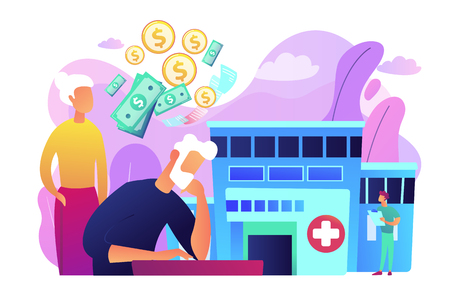1. Introduction to Professional Liability Insurance
Professional liability insurance, often known in the United States as Errors and Omissions (E&O) insurance or malpractice insurance (especially in healthcare), is a specialized form of coverage designed to protect professionals and their businesses from claims arising out of mistakes, negligence, or inadequate work. As the American business landscape has grown more complex and service-oriented, this type of insurance has become essential for a wide range of professions.
Definition
At its core, professional liability insurance provides protection when a client alleges that a professional’s advice, services, or actions have caused them financial harm. Unlike general liability insurance, which covers physical injuries or property damage, professional liability insurance focuses on intangible risks related to the quality of a professional’s work.
Purpose
The main purpose of this insurance is to shield professionals from potentially devastating lawsuits that can arise from honest mistakes or even unfounded claims. In the U.S., legal costs—even for groundless lawsuits—can be significant. Professional liability insurance helps cover:
- Legal defense fees
- Settlements and judgments
- Court costs
Essential Role in the American Business Environment
Many industries in America require professional liability coverage either by law or as part of standard business practices. For example, doctors are mandated to carry malpractice insurance, while real estate agents, consultants, architects, engineers, IT professionals, and accountants often need E&O coverage to maintain credibility and meet client contract requirements.
Who Needs Professional Liability Insurance?
| Profession | Common Risk Examples | Typical Requirement |
|---|---|---|
| Doctors & Healthcare Workers | Misdiagnosis, treatment errors | Legally required in most states |
| Lawyers | Mistakes in legal documents or advice | Often required by state bar associations |
| Consultants/Advisors | Poor advice leading to client losses | Frequently required by clients/contracts |
| IT Professionals | Software bugs causing data loss | Standard in tech contracts |
The Bottom Line: Why It Matters
The American business environment values trust and accountability. As businesses rely increasingly on specialized expertise and advice, the potential for disputes over service quality rises. Professional liability insurance is not just a safety net—it’s a foundation for operating with confidence and professionalism in today’s marketplace.
2. Historical Roots and Early Adoption in the U.S.
To understand how professional liability insurance became a crucial part of American business, it’s important to look at its historical roots and early adoption. This type of insurance didn’t just appear overnight; it grew out of real needs faced by professionals as America’s industries expanded and specialized.
Origins: Where Did It All Begin?
The origins of professional liability insurance in the United States can be traced back to the late 19th and early 20th centuries. As industries like law, medicine, and engineering became more complex, professionals started facing lawsuits related to mistakes or alleged negligence in their work. At first, there were few protections available, so one lawsuit could financially devastate a business or an individual expert.
Key Early Industries
| Industry | Reason for Early Adoption |
|---|---|
| Medical (Doctors & Hospitals) | High risk of malpractice suits due to patient care mistakes |
| Legal (Attorneys) | Lawsuits from clients over misrepresentation or errors in legal advice |
| Engineering & Architecture | Liability for design flaws, construction errors, or safety issues |
Notable Milestones in Professional Liability Insurance
The first professional liability policies were mostly customized agreements between a few insurers and large organizations. By the early 1900s, medical malpractice insurance became more widely available after several high-profile lawsuits against doctors made headlines. In the 1940s and 1950s, other professions like accountants, architects, and lawyers began seeking similar protections as their exposure to lawsuits increased.
Timeline of Important Events
| Year/Period | Milestone/Event |
|---|---|
| Late 1800s | First informal malpractice insurance arrangements among doctors in urban centers |
| Early 1900s | The creation of the first formal medical malpractice policies by U.S. insurers |
| 1940s-1950s | Expansion into legal and accounting fields; standardized policies become available for more professions |
| 1960s-1970s | The rapid growth of professional services leads to broader industry adoption nationwide |
Factors Driving Early Adoption in American Industries
A few major factors contributed to why professional liability insurance took off in the U.S.:
- Increasing Legal Risks: The American legal system allowed for significant damages in civil lawsuits, putting professionals at greater financial risk.
- Evolving Business Practices: As businesses grew larger and more specialized, mistakes or oversights could have bigger consequences.
- Public Expectations: Clients expected higher standards from professionals, and were more willing to sue if things went wrong.
- Professional Associations: Groups like the American Medical Association promoted insurance as a way to protect members’ livelihoods.
- Regulatory Changes: Some states began requiring certain types of professionals to carry liability coverage as part of their licensing requirements.

3. Key Drivers Behind Modern Evolution
Cultural Shifts in the American Workplace
Over the years, changes in American workplace culture have played a big role in shaping professional liability insurance. As businesses have become more service-oriented and customer expectations have risen, professionals are held to higher standards of accountability. The rise of social media and instant communication also means that mistakes or alleged errors can quickly become public, increasing reputational risks. This cultural shift has pushed insurance providers to offer coverage that goes beyond just financial loss, including protection for reputational damage.
Legal Influences and Regulatory Changes
The legal environment in the United States is constantly evolving. Lawsuits against professionals are more common than ever, with clients seeking compensation for even minor errors or perceived negligence. Federal and state regulations frequently change, requiring businesses to stay updated on compliance issues. For example, healthcare providers must follow HIPAA laws, while financial advisors adhere to SEC guidelines. Insurance policies now often include specific endorsements or riders to meet these unique legal requirements.
Examples of Legal Requirements by Industry
| Industry | Key Legal Regulations | Insurance Adaptation |
|---|---|---|
| Healthcare | HIPAA, State Medical Boards | Coverage for privacy breaches and malpractice claims |
| Finance | SEC, FINRA | Protection for regulatory investigations and client lawsuits |
| Technology | Data Security Laws | Errors & omissions (E&O) plus cyber liability extensions |
| Legal Services | ABA Guidelines, State Bar Rules | Mistakes in advice or representation coverage |
Economic Factors Impacting Coverage Needs
The American economy is always changing, which means new risks and opportunities for businesses. During economic downturns, there’s often an increase in claims as clients look for ways to recoup losses. At the same time, growth in industries like tech and healthcare creates new liability exposures that didn’t exist before. Insurance companies respond by creating tailored policies for emerging sectors and offering flexible premium options to match fluctuating business revenues.
Main Economic Drivers Affecting Professional Liability Insurance
| Economic Factor | Impact on Insurance Demand | Insurance Response |
|---|---|---|
| Recessions | Higher claim rates due to financial stress | Tighter underwriting; increased risk management support |
| Industry Growth (e.g., Tech) | New types of risks and liabilities arise rapidly | Specialized coverages like cyber liability added to policies |
| Mergers & Acquisitions | Complexity in professional responsibilities increases | Bespoke policy terms and due diligence services included |
| Remote Work Trends | Diverse locations introduce different legal jurisdictions and exposures | Nationwide policy options with multi-state compliance features offered |
The Ongoing Evolution of Coverage Options
The combination of these cultural, legal, and economic drivers means that professional liability insurance continues to adapt within the U.S. business landscape. Insurers now focus on offering customizable solutions that address not only traditional risks but also modern challenges faced by today’s professionals.
4. Major Industry Applications and Case Examples
Key Sectors Relying on Professional Liability Insurance
Professional liability insurance, often called errors and omissions (E&O) insurance, is essential in several American industries where the risk of lawsuits for professional mistakes or negligence runs high. Let’s explore how this coverage plays a pivotal role in healthcare, law, and consulting, using real-life scenarios that highlight its importance.
Healthcare: Protecting Providers and Patients
In the U.S., medical professionals like doctors, nurses, and therapists face significant exposure to malpractice claims. Even small errors can lead to costly lawsuits. For example, a well-known case involved a hospital in Florida where a patient received the wrong medication due to a clerical error. The resulting lawsuit exceeded $1 million in damages. Professional liability insurance not only helped cover the legal costs but also provided compensation for the affected patient. Without this coverage, many providers could face bankruptcy from a single claim.
Law: Safeguarding Legal Practices
Attorneys are trusted with sensitive client matters, so allegations of missed deadlines or poor advice can quickly turn into legal battles. In California, a law firm faced a lawsuit when it failed to file court documents on time, causing their client to lose their case. The professional liability policy covered defense costs and the settlement, which reached several hundred thousand dollars. This kind of protection is crucial for lawyers who must manage multiple cases and tight deadlines.
Consulting: Managing Advice Risks
Consultants provide expertise that businesses rely on for critical decisions. If their recommendations lead to financial losses or operational issues, clients may seek damages. For instance, an IT consulting firm in Texas advised a retail chain on new software implementation. When the rollout went poorly and led to significant downtime, the client sued for lost revenue. The consulting firm’s professional liability insurance handled both legal fees and the final payout.
Comparing Industry Needs for Professional Liability Coverage
| Industry | Common Risks Covered | Notable American Case Example |
|---|---|---|
| Healthcare | Misdiagnosis, treatment errors, medication mistakes | Florida hospital pays over $1M after medication error lawsuit |
| Law | Missed deadlines, incorrect legal advice | California firm covers large settlement after filing error |
| Consulting | Poor recommendations, project failures | Texas IT consultant sued for faulty software rollout losses |
The Takeaway for American Businesses
No matter the industry, professional liability insurance helps shield organizations from unexpected financial setbacks caused by human error or perceived negligence. As these cases show, coverage isn’t just recommended—it’s often vital for business survival in today’s litigious climate.
5. Emerging Trends and the Future Outlook
Technological Innovations Driving Change
One of the most significant trends shaping professional liability insurance in the United States is the rapid advancement of technology. From artificial intelligence to digital platforms, these innovations are transforming how insurers assess risk, process claims, and serve customers. Insurtech startups are introducing automation, making it faster and easier for professionals to get coverage or file claims. Additionally, big data analytics helps underwriters make more informed decisions about pricing policies and predicting potential losses.
Key Technological Trends
| Innovation | Impact on Professional Liability Insurance |
|---|---|
| Artificial Intelligence (AI) | Improves risk assessment accuracy and speeds up claims processing. |
| Blockchain Technology | Enhances transparency and security in policy management and claims tracking. |
| Telematics & IoT Devices | Provides real-time data for better monitoring of professional activities and reducing fraud. |
| Online Platforms & Mobile Apps | Makes purchasing, managing, and updating policies more convenient for clients. |
Shifting Regulatory Standards
The regulatory landscape for professional liability insurance is also evolving. As new professions emerge and traditional roles change due to technology, state and federal regulations are being updated to address novel risks. For example, regulations around cybersecurity practices have become much stricter in response to growing concerns over data breaches. Regulators are also focusing on greater transparency in policy terms to protect consumers from misunderstandings or hidden exclusions.
Main Areas of Regulatory Change
- Cybersecurity Requirements: Businesses must now meet higher standards for protecting sensitive client information, which affects their liability exposures and insurance needs.
- Licensing and Certification: Many states are reviewing requirements for professional licenses, impacting who needs coverage and what kind of coverage is required.
- Disclosure Rules: Insurers must provide clearer information about policy limits, exclusions, and claim procedures.
The Role of Changing Workforce Dynamics
The rise of freelance professionals and gig economy workers has created demand for more flexible liability insurance solutions. Traditional one-size-fits-all policies do not always fit independent contractors or remote workers. Insurers are responding with customizable plans that can be scaled up or down based on the unique risks faced by each professional.
Examples of Flexible Coverage Options:
- Short-term policies for project-based work
- Add-on endorsements for specific services or skills
- Coverage portability for professionals working across multiple states
The Road Ahead: What to Expect Next?
The future of professional liability insurance in America will likely feature even more personalized products, increased use of digital technologies, and ongoing adjustments to regulatory frameworks. Professionals can expect easier access to insurance solutions tailored specifically to their evolving needs as both technology and business environments continue to advance.


